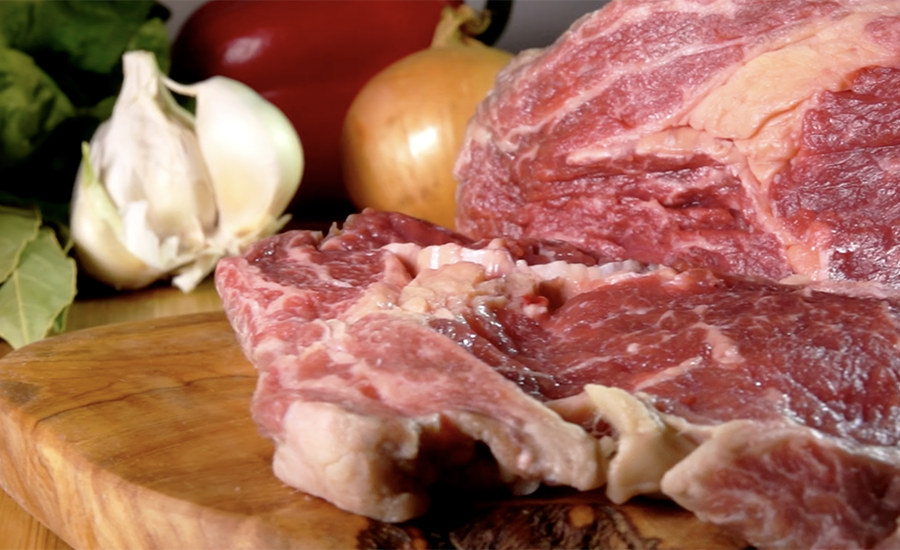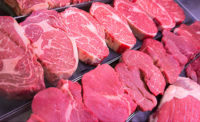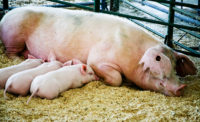Tumbling without brine inclusion: A new strategy for tenderizing beef?
Research suggests it could allow fresh beef steaks to reach desired tenderness in less time.

Tenderness of fresh beef is an area that has been studied extensively in meat science research. Recently, it has been assessed that if a steak is rated by a consumer to have acceptable tenderness, the likelihood of overall palatability being unacceptable would be only 10% (O’Quinn et al., 2018). Undoubtedly, the industry has made considerable progress in improving the tenderness of beef in the US, as documented by the National Beef Tenderness Surveys (Gonzalez & Phelps, 2018). However, considerable lengths of postmortem aging are often used to achieve this. For instance, the latest National Beef Tenderness Survey reported the mean post-fabrication aging time for strip loins would be 27.2 days (Martinez et al., 2017). Considering this, we began examining potential strategies that could allow fresh beef steaks to reach the same level of tenderness in a shorter time.
Taking inspiration from the meat processing industry, we examined if tumbling would have beneficial impacts on the quality attributes of fresh beef loins. Although tumbling is nearly universally applied alongside enhancement with a brine or marinade solution, we questioned if brine inclusion was truly a necessary component for fresh meat application. One previous study conducted by Morrow et al. (2019) suggested that it was. Beef flanks that were tumbled in the absence of a marinade did not have similar improvements in palatability compared to those tumbled with a marinade (Morrow et al., 2019). However, considering the flank is a sheet muscle with large muscle fibers and a high content of connective tissue, we proposed that tumbling alone could exert some positive effects on the quality attributes of beef loins. Additionally, we intended to examine if additional postmortem aging applied after the tumbling process would have added benefits, potentially showing synergism between physical disruptions and proteolytic degradation.

To accomplish this, we took beef loin muscles from nine USDA Select carcasses and divided each into three equal-length sections. Each section was then vacuum-packaged within two layers of 3-mil packaging to ensure the bag maintained its seal over the course of tumbling. Sections were then divided among our treatment groups: T0 (non-tumbled), T60 (tumbled for 60 min at 8.5 rpm), and T90 (tumbled for 90 min at 8.5 rpm). At the completion of tumbling, steaks were cut from each section to be further aged for an additional zero, seven or 14 days.
Tenderness was assessed by Warner-Bratzler shear force (WBSF) values. Immediately after the tumbling process, we observed a considerable decrease in WBSF in the T60 (29.0% decrease) and T90 (37.9% decrease) groups relative to the T0 controls. In fact, steaks from sections that were not tumbled took an additional 14 days of aging to reach a comparable WBSF level to what was achieved immediately after the tumbling process (Figure 1). To support these findings, we conducted several other assays related to beef tenderness. Tumbled loins had greater myofibrillar fragmentation index values, which was supported by obvious fracturing of the myofibrils when examined microscopically. Further, there was evidence to suggest that tumbling facilitates degradation of myofibrillar proteins during the aging process, shown by less abundant intact troponin-T.
Although there were obvious benefits to tenderness obtained through tumbling without brine inclusion, the method did have some drawbacks. Unsurprisingly, tumbled steaks lost significantly more moisture during the cooking process, which may be expected to negatively impact juiciness. However, since conducting this study (published in Meat and Muscle Biology; https://doi.org/10.22175/mmb.13044), we have assessed eating quality attributes through consumer panel. In our follow-up study (accepted for publication in Journal of Animal Science), consumers rated tumbled loins as having greater tenderness liking and overall liking compared to those that were not tumbled, with no negative impacts to juiciness or flavor.
Accordingly, tumbling without brine inclusion, combined with additional postmortem aging, could be an effective, novel strategy for improving beef palatability. While most loin steaks in the U.S. do reach acceptable levels of tenderness before reaching the consumer (Martinez et al., 2017), tumbling could potentially be used to achieve this sooner after harvest. We have since been conducting follow-up experiments to determine the effectiveness of the process under situations where toughness is more of an issue, including cuts from the round and sirloin primals, as well as loins from cull cows. While there is undoubtedly more work that must be done before industry application (e.g., identifying the optimal tumbling regime and assessing food safety), our research does show promise for this strategy as an effective, simple, and natural method for processors to implement to provide consumers with guaranteed tender products.
Acknowledgments
This work was supported by the U.S. Department of Agriculture’s National Institute of Food and Agriculture, Hatch-Multistate project 1006773, and funded in part by the Beef Checkoff.
References
Gonzalez, J. M., & Phelps, K. J. (2018). United States beef quality as chronicled by the National Beef Quality Audits, Beef Consumer Satisfaction Projects, and National Beef Tenderness Surveys—A review. Asian-Australasian Journal of Animal Sciences, 31(7), 1036–1042. https://doi.org/10.5713/ajas.18.0199
Martinez, H. A., Arnold, A. N., Brooks, J. C., Carr, C. C., Gehring, K. B., Griffin, D. B., Hale, D. S., Mafi, G. G., Johnson, D. D., Lorenzen, C. L., Maddock, R. J., Miller, R. K., VanOverbeke, D. L., Wasser, B. E., & Savell, J. W. (2017). National Beef Tenderness Survey–2015: Palatability and Shear Force Assessments of Retail and Foodservice Beef. Meat and Muscle Biology, 1(1), 138. https://doi.org/10.22175/mmb2017.05.0028
Morrow, S. J., Garmyn, A. J., Hardcastle, N. C., Brooks, J. C., & Miller, M. F. (2019). The Effects of Enhancement Strategies of Beef Flanks on Composition and Consumer Palatability Characteristics. Meat and Muscle Biology, 3(1), 457. https://doi.org/10.22175/mmb2019.07.0030
O’Quinn, T. G., Legako, J. F., Brooks, J. C., & Miller, M. F. (2018). Evaluation of the contribution of tenderness, juiciness, and flavor to the overall consumer beef eating experience1. Translational Animal Science, 2(1), 26–36. https://doi.org/10.1093/tas/txx008
Looking for a reprint of this article?
From high-res PDFs to custom plaques, order your copy today!





